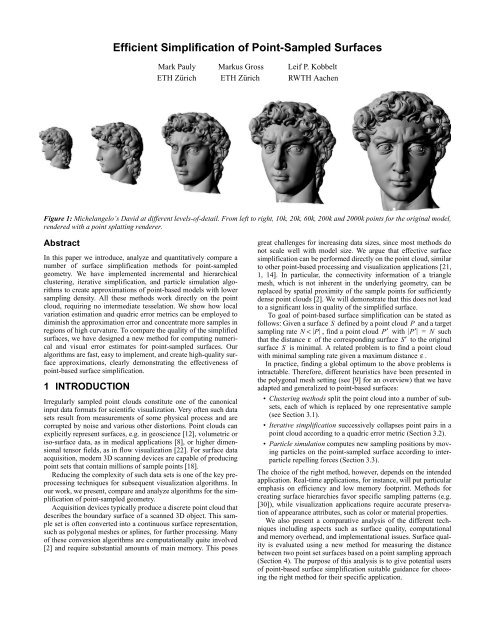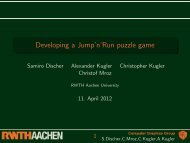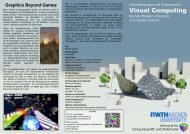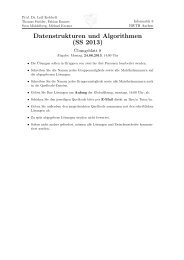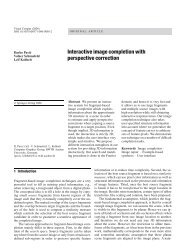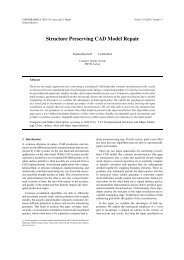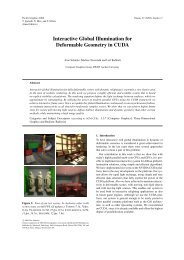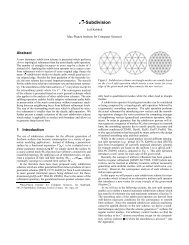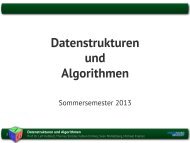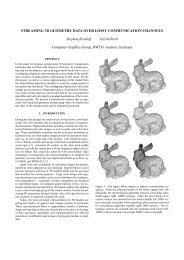Efficient Simplification of Point-Sampled Surfaces - Computer ...
Efficient Simplification of Point-Sampled Surfaces - Computer ...
Efficient Simplification of Point-Sampled Surfaces - Computer ...
You also want an ePaper? Increase the reach of your titles
YUMPU automatically turns print PDFs into web optimized ePapers that Google loves.
<strong>Efficient</strong> <strong>Simplification</strong> <strong>of</strong> <strong>Point</strong>-<strong>Sampled</strong> <strong>Surfaces</strong><br />
Mark Pauly Markus Gross Leif P. Kobbelt<br />
ETH Zürich ETH Zürich RWTH Aachen<br />
Figure 1: Michelangelo’s David at different levels-<strong>of</strong>-detail. From left to right, 10k, 20k, 60k, 200k and 2000k points for the original model,<br />
rendered with a point splatting renderer.<br />
Abstract<br />
In this paper we introduce, analyze and quantitatively compare a<br />
number <strong>of</strong> surface simplification methods for point-sampled<br />
geometry. We have implemented incremental and hierarchical<br />
clustering, iterative simplification, and particle simulation algorithms<br />
to create approximations <strong>of</strong> point-based models with lower<br />
sampling density. All these methods work directly on the point<br />
cloud, requiring no intermediate tesselation. We show how local<br />
variation estimation and quadric error metrics can be employed to<br />
diminish the approximation error and concentrate more samples in<br />
regions <strong>of</strong> high curvature. To compare the quality <strong>of</strong> the simplified<br />
surfaces, we have designed a new method for computing numerical<br />
and visual error estimates for point-sampled surfaces. Our<br />
algorithms are fast, easy to implement, and create high-quality surface<br />
approximations, clearly demonstrating the effectiveness <strong>of</strong><br />
point-based surface simplification.<br />
1 INTRODUCTION<br />
Irregularly sampled point clouds constitute one <strong>of</strong> the canonical<br />
input data formats for scientific visualization. Very <strong>of</strong>ten such data<br />
sets result from measurements <strong>of</strong> some physical process and are<br />
corrupted by noise and various other distortions. <strong>Point</strong> clouds can<br />
explicitly represent surfaces, e.g. in geoscience [12], volumetric or<br />
iso-surface data, as in medical applications [8], or higher dimensional<br />
tensor fields, as in flow visualization [22]. For surface data<br />
acquisition, modern 3D scanning devices are capable <strong>of</strong> producing<br />
point sets that contain millions <strong>of</strong> sample points [18].<br />
Reducing the complexity <strong>of</strong> such data sets is one <strong>of</strong> the key preprocessing<br />
techniques for subsequent visualization algorithms. In<br />
our work, we present, compare and analyze algorithms for the simplification<br />
<strong>of</strong> point-sampled geometry.<br />
Acquisition devices typically produce a discrete point cloud that<br />
describes the boundary surface <strong>of</strong> a scanned 3D object. This sample<br />
set is <strong>of</strong>ten converted into a continuous surface representation,<br />
such as polygonal meshes or splines, for further processing. Many<br />
<strong>of</strong> these conversion algorithms are computationally quite involved<br />
[2] and require substantial amounts <strong>of</strong> main memory. This poses<br />
great challenges for increasing data sizes, since most methods do<br />
not scale well with model size. We argue that effective surface<br />
simplification can be performed directly on the point cloud, similar<br />
to other point-based processing and visualization applications [21,<br />
1, 14]. In particular, the connectivity information <strong>of</strong> a triangle<br />
mesh, which is not inherent in the underlying geometry, can be<br />
replaced by spatial proximity <strong>of</strong> the sample points for sufficiently<br />
dense point clouds [2]. We will demonstrate that this does not lead<br />
to a significant loss in quality <strong>of</strong> the simplified surface.<br />
To goal <strong>of</strong> point-based surface simplification can be stated as<br />
follows: Given a surface S defined by a point cloud P and a target<br />
sampling rate N < P , find a point cloud P′ with P′ = N such<br />
that the distance ε <strong>of</strong> the corresponding surface S′ to the original<br />
surface S is minimal. A related problem is to find a point cloud<br />
with minimal sampling rate given a maximum distance ε .<br />
In practice, finding a global optimum to the above problems is<br />
intractable. Therefore, different heuristics have been presented in<br />
the polygonal mesh setting (see [9] for an overview) that we have<br />
adapted and generalized to point-based surfaces:<br />
• Clustering methods split the point cloud into a number <strong>of</strong> subsets,<br />
each <strong>of</strong> which is replaced by one representative sample<br />
(see Section 3.1).<br />
• Iterative simplification successively collapses point pairs in a<br />
point cloud according to a quadric error metric (Section 3.2).<br />
• Particle simulation computes new sampling positions by moving<br />
particles on the point-sampled surface according to interparticle<br />
repelling forces (Section 3.3).<br />
The choice <strong>of</strong> the right method, however, depends on the intended<br />
application. Real-time applications, for instance, will put particular<br />
emphasis on efficiency and low memory footprint. Methods for<br />
creating surface hierarchies favor specific sampling patterns (e.g.<br />
[30]), while visualization applications require accurate preservation<br />
<strong>of</strong> appearance attributes, such as color or material properties.<br />
We also present a comparative analysis <strong>of</strong> the different techniques<br />
including aspects such as surface quality, computational<br />
and memory overhead, and implementational issues. Surface quality<br />
is evaluated using a new method for measuring the distance<br />
between two point set surfaces based on a point sampling approach<br />
(Section 4). The purpose <strong>of</strong> this analysis is to give potential users<br />
<strong>of</strong> point-based surface simplification suitable guidance for choosing<br />
the right method for their specific application.
Earlier methods for simplification <strong>of</strong> point-sampled models<br />
have been introduced by Alexa et al. [1] and Linsen [20]. These<br />
algorithms create a simplified point cloud that is a true subset <strong>of</strong><br />
the original point set, by ordering iterative point removal operations<br />
according to a surface error metric. While both papers report<br />
good results for reducing redundancy in point sets, pure subsampling<br />
unnecessarily restricts potential sampling positions, which<br />
can lead to aliasing artefacts and uneven sampling distributions. To<br />
alleviate these problems, the algorithms described in this paper<br />
resample the input surface and implicitly apply a low-pass filter<br />
(e.g. clustering methods perform a local averaging step to compute<br />
the cluster’s centroid).<br />
In [21], Pauly and Gross introduced a resampling strategy based<br />
on Fourier theory. They split the model surface into a set <strong>of</strong><br />
patches that are resampled individually using a spectral decomposition.<br />
This method directly applies signal processing theory to<br />
point-sampled geometry, yielding a fast and versatile point cloud<br />
decimation method. Potential problems arise due to the dependency<br />
on the specific patch layout and difficulties in controlling<br />
the target model size by specifying spectral error bounds.<br />
Depending on the intended application, working directly on the<br />
point cloud that represents the surface to be simplified <strong>of</strong>fers a<br />
number <strong>of</strong> advantages:<br />
• Apart from geometric inaccuracies, noise present in physical<br />
data can also lead to topological distortions, e.g. erroneous<br />
handles or loops, which cause many topology-preserving simplification<br />
algorithms to produce inferior results (see [32], Figure<br />
3). <strong>Point</strong>-based simplification does not consider local<br />
topology and is thus not affected by these problems. If topological<br />
invariance is required, however, point-based simplification<br />
is not appropriate.<br />
• <strong>Point</strong>-based simplification can significantly increase performance<br />
when creating coarse polygonal approximations <strong>of</strong><br />
large point sets. Instead <strong>of</strong> using a costly surface reconstruction<br />
for a detailed point cloud followed by mesh simplification,<br />
we first simplify the point cloud and only apply the<br />
surface reconstruction for the much smaller, simplified point<br />
set. This reconstruction will also be more robust, since geometric<br />
and topological noise is removed during the point-based<br />
simplification process.<br />
• Upcoming point-based visualization methods [14, 25, 23] can<br />
benefit from the presented simplification algorithms as different<br />
level-<strong>of</strong>-detail approximations can be directly computed<br />
from their inherent data structures.<br />
• The algorithms described in this paper are time and memory<br />
efficient and easy to implement. Unlike triangle simplification,<br />
no complex mesh data structures have to be build and maintained<br />
during the simplification, leading to an increased overall<br />
performance.<br />
We should note that our algorithms are targeted towards denselysampled<br />
organic shapes stemming from 3D acquisition, iso-surface<br />
extraction or sampling <strong>of</strong> implicit functions. They are not<br />
suited for surfaces that have been carefully designed in a particular<br />
surface representation, such as low-resolution polygonal CAD<br />
data. Also our goal is to design algorithms that are general in the<br />
sense that they do not require any knowledge <strong>of</strong> the specific source<br />
<strong>of</strong> the data. For certain applications this additional knowledge<br />
could be exploited to design a more effective simplification algorithm,<br />
but this would also limit the applicability <strong>of</strong> the method.<br />
2 LOCAL SURFACE PROPERTIES<br />
In this section we describe how we estimate local surface properties<br />
from the underlying point cloud. These techniques will be used<br />
in the simplification algorithms presented below: Iterative simplification<br />
(Section 3.2) requires an accurate estimation <strong>of</strong> the tangent<br />
plane, while clustering (Section 3.1) employs a surface variation<br />
estimate (Section 2.1). Particle simulation (Section 3.3) makes use<br />
<strong>of</strong> both methods and additionally applies a moving least-squares<br />
projection operator (Section 2.2) that will also be used for measuring<br />
surfaces error in Section 4.<br />
Our algorithms take as input an unstructured point cloud<br />
P = { p i<br />
∈ IR 3 } describing a smooth, two-manifold boundary<br />
surface S <strong>of</strong> a 3D object. The computations <strong>of</strong> local surface properties<br />
are based on local neighborhoods <strong>of</strong> sample points. We<br />
found that the set <strong>of</strong> k -nearest neighbors <strong>of</strong> a sample p ∈ P ,<br />
denoted by the index set N p , works well for all our models. More<br />
sophisticated neighborhoods, e.g. Floater’s method based on local<br />
Delaunay triangulations [5] or Linsen’s angle criterion [20] could<br />
be used for highly non-uniformly sampled models at the expense<br />
<strong>of</strong> higher computational overhead. To obtain an estimate <strong>of</strong> the<br />
local sampling density ρ at a point p , we define ρ = k⁄<br />
r 2 ,<br />
where r is the radius <strong>of</strong> the enclosing sphere <strong>of</strong> the k-nearest<br />
neighbors <strong>of</strong> p given by r = max i ∈ Np<br />
p – p i<br />
.<br />
2.1 Covariance Analysis<br />
As has been demonstrated in earlier work (e.g. [11] and [27]),<br />
eigenanalysis <strong>of</strong> the covariance matrix <strong>of</strong> a local neighborhood can<br />
be used to estimate local surface properties. The 3×<br />
3 covariance<br />
matrix C for a sample point p is given by<br />
C =<br />
p i1<br />
p ik<br />
– p<br />
…<br />
– p<br />
T<br />
⋅<br />
, (1)<br />
where p is the centroid <strong>of</strong> the neighbors p ij<br />
<strong>of</strong> p (see Figure 2).<br />
Consider the eigenvector problem<br />
C⋅ v l<br />
= λ l<br />
⋅ v l<br />
, l ∈ { 012 , , }. (2)<br />
Since C is symmetric and positive semi-definite, all eigenvalues<br />
λ l<br />
are real-valued and the eigenvectors v l<br />
form an orthogonal<br />
frame, corresponding to the principal components <strong>of</strong> the point set<br />
defined by N p<br />
[13]. The λ l<br />
measure the variation <strong>of</strong> the<br />
p i<br />
, i ∈ N p<br />
, along the direction <strong>of</strong> the corresponding eigenvectors.<br />
The total variation, i.e. the sum <strong>of</strong> squared distances <strong>of</strong> the p i<br />
from their center <strong>of</strong> gravity is given by<br />
p<br />
p i<br />
2<br />
∑<br />
p i<br />
– p = λ 0<br />
+ λ 1<br />
+ λ 2<br />
. (3)<br />
i ∈<br />
r<br />
N p<br />
N p<br />
(a)<br />
(b)<br />
Figure 2: Local neighborhood (a) and covariance analysis (b).<br />
p i1<br />
p ik<br />
T( x)<br />
– p<br />
… ,<br />
– p<br />
Normal Estimation. Assuming λ 0<br />
≤λ 1<br />
≤λ 2<br />
, it follows that<br />
the plane<br />
T( x): ( x–<br />
p) ⋅ v 0<br />
= 0<br />
(4)<br />
through p minimizes the sum <strong>of</strong> squared distances to the neighbors<br />
<strong>of</strong> p [13]. Thus v 0<br />
approximates the surface normal n p<br />
at<br />
p, or in other words, v 1<br />
and v 2<br />
span the tangent plane at p . To<br />
compute a consistent orientation <strong>of</strong> the normal vectors, we use a<br />
method based on the minimum spanning tree, as described in [11].<br />
i j<br />
λ 1<br />
v 1<br />
∈<br />
N p<br />
λ 0<br />
v 0<br />
p i<br />
p<br />
covariance ellipsoid
Clustering methods have been used in many computer graphics<br />
applications to reduce the complexity <strong>of</strong> 3D objects. Rossignac<br />
and Borrel, for example, used vertex clustering to obtain multiresolution<br />
approximations <strong>of</strong> complex polygonal models for fast rendering<br />
[24]. The standard strategy is to subdivide the model’s<br />
bounding box into grid cells and replace all sample points that fall<br />
into the same cell by a common representative. This volumetric<br />
approach has some drawbacks, however. By using a grid <strong>of</strong> fixed<br />
size this method cannot adapt to non-uniformities in the sampling<br />
distribution. Furthermore, volumetric clustering easily joins<br />
unconnected parts <strong>of</strong> a surface, if the grid cells are too large. To<br />
alleviate these shortcomings, we use a surface-based clustering<br />
approach, where clusters are build by collecting neighboring samples<br />
while regarding local sampling density. We distinguish two<br />
general approaches for building clusters. An incremental<br />
approach, where clusters are created by region-growing, and a<br />
hierarchical approach that splits the point cloud into smaller sub-<br />
Surface Variation. λ 0<br />
quantitatively describes the variation<br />
along the surface normal, i.e. estimates how much the points deviate<br />
from the tangent plane (4). We define<br />
σ n<br />
( p)<br />
=<br />
as the surface variation at point p in a neighborhood <strong>of</strong> size n . If<br />
σ n<br />
( p) = 0 , all points lie in the plane. The maximum surface variation<br />
σ n<br />
( p) = 1⁄<br />
3 is assumed for completely isotropically distributed<br />
points. Note that surface variation is not an intrinsic<br />
feature <strong>of</strong> a point-sampled surface, but depends on the size <strong>of</strong> the<br />
neighborhood. Note also that λ 1<br />
and λ 2<br />
describe the variation <strong>of</strong><br />
the sampling distribution in the tangent plane and can thus be used<br />
to estimate local anisotropy.<br />
Many surface simplification algorithms use curvature estimation<br />
to decrease the error <strong>of</strong> the simplified surface by concentrating<br />
more samples in regions <strong>of</strong> high curvature. As Figure 3 illustrates,<br />
surface variation is closely related to curvature.<br />
However, σ n<br />
is more suitable for simplification<br />
<strong>of</strong> point-sampled surfaces than cur-<br />
N p<br />
vature estimation based on function fitting.<br />
p<br />
Consider a surface with two opposing flat<br />
parts that come close together. Even though a<br />
low curvature would indicate that few sampling<br />
points are required to adequately represent<br />
the surface, for point-based surfaces we need a high sample<br />
density to be able to distinguish the different parts <strong>of</strong> the surface.<br />
This is more adequately captured by the variation measure .<br />
2.2 Moving Least Squares <strong>Surfaces</strong><br />
Recently, Levin has introduced a new point-based surface representation<br />
called moving least squares (MLS) surfaces [17]. Based<br />
on this representation, Alexa et al. have implemented a high-quality<br />
rendering algorithm for point set surfaces [1]. We will briefly<br />
review the MLS projection operator and discuss an extension for<br />
non-uniform sampling distributions.<br />
Given a point set P, the MLS surface S MLS ( P)<br />
is defined<br />
implicitly by a projection operator Ψ as the points that project<br />
onto themselves, i.e. S MLS ( P) = { x∈<br />
IR 3 Ψ( P,<br />
x)<br />
= x}<br />
.<br />
Ψ( P,<br />
r)<br />
is defined by a two-step procedure: First a local reference<br />
plane H = { x∈ IR 3 x⋅<br />
n– D = 0}<br />
is computed by minimizing<br />
the weighted sum <strong>of</strong> squared distances<br />
∑<br />
p ∈ P<br />
(5)<br />
, (6)<br />
where q is the projection <strong>of</strong> r onto H and h is a global scale factor.<br />
Then a bivariate polynomial guv ( , ) is fitted to the points projected<br />
onto the reference plane H using a similar weighted least<br />
squares optimization. The projection <strong>of</strong> r onto S MLS<br />
( P)<br />
is then<br />
given as Ψ( P,<br />
r) = q + g( 00 , ) ⋅ n (for more details see [17, 1]).<br />
Adaptive MLS <strong>Surfaces</strong>. Finding a suitable global scale factor<br />
h can be difficult for non-uniformly sampled point clouds. In<br />
regions <strong>of</strong> high sampling density many points need to be considered<br />
in the least squares equations leading to high computational<br />
cost. Even worse, if the sampling density is too low, only very few<br />
points will contribute to Equation (6) due to the exponential fall<strong>of</strong>f<br />
<strong>of</strong> the weight function. This can cause instabilities in the optimization<br />
which lead to wrong surface approximations. We propose<br />
an extension <strong>of</strong> the static MLS approach, where instead <strong>of</strong> considering<br />
samples within a fixed radius proportional to h , we collect<br />
the k-nearest neighbors and adapt h according to the radius r <strong>of</strong><br />
the enclosing sphere. By dynamically choosing h = r⁄<br />
3 , we<br />
ensure that only points within the k -neighborhood contribute<br />
noticeably to the least-squares optimization <strong>of</strong> Equation (6). While<br />
λ 0<br />
-----------------------------<br />
λ 0<br />
+ λ 1<br />
+ λ 2<br />
( p⋅<br />
n–<br />
D) 2 –<br />
e r q<br />
– 2 2<br />
⁄ h<br />
σ n<br />
our experiments indicate that this adaptive scheme is more robust<br />
than the standard method, a mathematical analysis <strong>of</strong> the implications<br />
remains to be done.<br />
(a) original surface<br />
(c) variation σ 20 (d) variation σ 50<br />
Figure 3: Comparison <strong>of</strong> surface curvature and surface variation<br />
on the igea model (a). In (b), curvature is computed analytically<br />
from a cubic polynomial patch fitted to the point set using moving<br />
least squares (see Section 2.2). (c) and (d) show surface variation<br />
for different neighborhood sizes.<br />
3 SURFACE SIMPLIFICATION METHODS<br />
In this section we present a number <strong>of</strong> simplification algorithms<br />
for surfaces represented by discrete point clouds: Clustering methods<br />
are fast and memory-efficient, iterative simplification puts<br />
more emphasis on high surface quality, while particle simulation<br />
allows intuitive control <strong>of</strong> the resulting sampling distribution.<br />
After describing the technical details, we will discuss the specific<br />
pros and cons <strong>of</strong> each method in more detail in Section 5.<br />
3.1 Clustering<br />
(b) mean curvature
p C<br />
sets in a top-down manner [3, 27]. Both methods create a set { C i<br />
}<br />
<strong>of</strong> clusters, each <strong>of</strong> which is replaced by a representative sample,<br />
typically its centroid, to create the simplified point cloud P′ .<br />
Clustering by Region-growing. Starting from a random seed<br />
point , a cluster is built by successively adding nearest<br />
0 0<br />
neighbors. This incremental region-growing is terminated when<br />
the size <strong>of</strong> the cluster reaches a maximum bound. Additionally, we<br />
can restrict the maximum allowed variation σ n<br />
<strong>of</strong> each cluster.<br />
This results in a curvature-adaptive clustering method, where more<br />
and smaller clusters are created in regions <strong>of</strong> high surface variation.<br />
The next cluster is then build by starting the incremental<br />
C 1<br />
growth with a new seed chosen from the neighbors <strong>of</strong> C 0<br />
and<br />
excluding all points <strong>of</strong> C 0<br />
from the region-growing. Due to fragmentation,<br />
this method creates many clusters that did not reach the<br />
maximum size or variation bound, but whose incremental growth<br />
was restricted by adjacent clusters. To obtain a more even distribution<br />
<strong>of</strong> clusters, we distribute the sample points <strong>of</strong> all clusters that<br />
did not reach a minimum size and variation bound (typically half<br />
the values <strong>of</strong> the corresponding maximum bounds) to neighboring<br />
clusters (see Figure 4 (a)). Note that this potentially increases the<br />
size and variation <strong>of</strong> the clusters beyond the user-specified maxima.<br />
Figure 5: Clustering: Uniform incremental clustering is shown in<br />
The split plane is defined by the centroid <strong>of</strong> P and the eigenvector matrix Q v<br />
. The quality <strong>of</strong> the collapse ( v 1<br />
, v 2<br />
) → v is then rated<br />
v <strong>of</strong> the covariance matrix <strong>of</strong> with largest corresponding according to the minimum <strong>of</strong> the error functional<br />
2<br />
P<br />
eigenvector (see Figure 2 (b)). Hence the point cloud is always Q v<br />
= Q v1<br />
+ Q v2<br />
.<br />
split along the direction <strong>of</strong> greatest variation (see also [3, 27]). If In order to adapt this technique to the decimation <strong>of</strong> unstructured<br />
point clouds we use the k -nearest neighbor relation, since<br />
the splitting criterion is not fulfilled, the point cloud P becomes a<br />
cluster C i<br />
. As shown in Figure 4 (b), hierarchical clustering builds manifold surface connectivity is not available. To initialize the<br />
a binary tree, where each leaf <strong>of</strong> the tree corresponds to a cluster. A error quadrics for every point sample p , we estimate a tangent<br />
straightforward extension to the recursive scheme uses a priority plane E i<br />
for every edge that connects p with one <strong>of</strong> its neighbors<br />
queue to order the splitting operations [3, 27]. While this leads to a p i<br />
. This tangent plane is spanned by the vector e i<br />
= p – p i<br />
and<br />
significant increase in computation time, it allows direct control b i<br />
= e i<br />
× n , where n is the estimated normal vector at p. After<br />
over the number <strong>of</strong> generated samples, which is difficult to achieve this initialization the point cloud decimation works exactly like<br />
by specifying n max<br />
and σ max<br />
only. Figure 5 illustrates both incremental<br />
and hierarchical clustering, where we use oriented circular its ancestors p 1<br />
mesh decimation with the point p inheriting the neighborhoods <strong>of</strong><br />
and p 2<br />
and being assigned the error functional<br />
splats to indicate the sampling distribution.<br />
Q v<br />
= Q v1<br />
+ Q v2<br />
. Figure 6 shows an example <strong>of</strong> a simplified point<br />
cloud created by iterative point-pair contraction.<br />
3.2 Iterative <strong>Simplification</strong><br />
3.3 Particle Simulation<br />
A different strategy for point-based surface simplification iteratively<br />
C 2<br />
leaf node<br />
split plane the left column, adaptive hierarchical clustering in the right column.<br />
The top row illustrates the clusters on the original point set,<br />
=cluster<br />
the bottom row the resulting simplified point set (1000 points),<br />
v 2 centroid<br />
where the size <strong>of</strong> the splats corresponds to cluster size.<br />
error metric that quantifies the error caused by the decimation. The<br />
iteration is then performed in such a way that the decimation operation<br />
causing the smallest error is applied first. Earlier work [1],<br />
0 C 1<br />
C<br />
[20] uses simple point removal, i.e. points are iteratively removed<br />
(a)<br />
(b)<br />
from the point cloud, resulting in a simplified point cloud that is a<br />
Figure 4: (a) Clustering by incremental region growing, where<br />
“stray samples” (black dots) are attached to the cluster with closest<br />
centroid. (b) Hierarchical clustering, where the thickness <strong>of</strong> the<br />
lines indicates the level <strong>of</strong> the BSP tree (2D for illustration).<br />
subset <strong>of</strong> the original point set. As discussed above, true subsampling<br />
is prone to aliasing and <strong>of</strong>ten creates uneven sampling distributions.<br />
Therefore, we use point-pair contraction, an extension <strong>of</strong><br />
the common edge collapse operator, which replaces two points p 1<br />
and p 2<br />
by a new point p . To rate the contraction operation, we<br />
Hierarchical Clustering. A different method for computing use an adaptation <strong>of</strong> the quadric error metric presented for polygonal<br />
the set <strong>of</strong> clusters recursively splits the point cloud using a binary<br />
space partition. The point cloud P is split if:<br />
meshes in [6]. The idea here is to approximate the surface<br />
locally by a set <strong>of</strong> tangent planes and to estimate the geometric<br />
• The size P is larger than the user specified maximum cluster<br />
deviation <strong>of</strong> a mesh vertex v from the surface by the sum <strong>of</strong> the<br />
size n or<br />
squared distances to these planes. The error quadrics for each vertex<br />
v are initialized with a set <strong>of</strong> planes defined by the triangles<br />
max<br />
• the variation σ n<br />
( P) is above a maximum threshold σ max<br />
. around that vertex and can be represented by a symmetric 4×<br />
4<br />
reduces the number <strong>of</strong> points using an atomic decimation<br />
operator. This approach is very similar to mesh-based simplification<br />
methods for creating progressive meshes [10]. Decimation<br />
operations are usually arranged in a priority queue according to an<br />
In [29], Turk introduced a method for resampling polygonal surfaces<br />
using particle simulation. The desired number <strong>of</strong> particles is<br />
randomly spread across the surface and their position is equalized<br />
using a point repulsion algorithm. <strong>Point</strong> movement is restricted to
p is kept on the surface by simply projecting it onto the tangent<br />
plane <strong>of</strong> the point p′ <strong>of</strong> the original point cloud that is closest to<br />
p . Only at the end <strong>of</strong> the simulation, we apply the full moving<br />
least squares projection, which alters the particle positions only<br />
slightly and does not change the sampling distribution noticeably.<br />
Adaptive Simulation. Using the variation estimate <strong>of</strong> Section<br />
2.1, we can concentrate more points in regions <strong>of</strong> high curvature<br />
by scaling their repulsion radius with the inverse <strong>of</strong> the variation<br />
σ n<br />
. It is also important to adapt the initial spreading <strong>of</strong> particles<br />
accordingly to ensure fast convergence. This can be done by<br />
replacing the density estimate ρ by ρ ⋅ σ n<br />
. Figure 7 gives an<br />
example <strong>of</strong> an adaptive particle simulation.<br />
Figure 6: Iterative simplification <strong>of</strong> the Isis model from 187,664<br />
(left) to 1,000 sample points (middle). The right image shows all remaining<br />
potential point-pair contractions indicated as an edge between<br />
two points. Note that these edges do not necessarily form a<br />
consistent triangulation <strong>of</strong> the surface.<br />
the surface defined by the individual polygons to ensure an accurate<br />
approximation <strong>of</strong> the original surface. Turk also included a<br />
curvature estimation method to concentrate more samples in<br />
regions <strong>of</strong> high curvature. Finally, the new vertices are re-triangulated<br />
yielding the resampled triangle mesh. This scheme can easily<br />
be adapted to point-sampled geometry.<br />
Spreading Particles. Turk initializes the particle simulation<br />
by randomly distributing points on the surface. Since a uniform<br />
initial distribution is crucial for fast convergence, this random<br />
choice is weighted according to the area <strong>of</strong> the polygons. For<br />
point-based models, we can replace this area measure by a density<br />
estimate ρ (see Section 2). Thus by placing more samples in<br />
regions <strong>of</strong> lower sampling density (which correspond to large triangles<br />
in the polygonal setting), uniformity <strong>of</strong> the initial sample<br />
distribution can ensured.<br />
Repulsion. We use the same linear repulsion force as in [29],<br />
because its radius <strong>of</strong> influence is finite, i.e. the force vectors can be<br />
computed very efficiently as<br />
F i<br />
( p) = kr ( – p – p i<br />
) ⋅ ( p – p i<br />
), (7)<br />
where F i<br />
( p) is the force exerted on particle p due to particle p i<br />
,<br />
k is a force constant and r is the repulsion radius. The total force<br />
exertedonp<br />
isthengivenas<br />
∑<br />
F( p) = F i<br />
( p)<br />
, (8)<br />
i∈<br />
where N p<br />
is the neighborhood <strong>of</strong> p with radius r . Using a 3D<br />
grid data structure, this neighborhood can be computed efficiently<br />
in constant time.<br />
Projection. In Turk’s method, displaced particles are projected<br />
onto the closest triangle to prevent to particles from drifting away<br />
from the surface. Since we have no explicit surface representation<br />
available, we use the MLS projection operator Ψ (see Section 2.2)<br />
to keep the particles on the surface. However, applying this projection<br />
every time a particle position is altered is computationally too<br />
expensive. Therefore, we opted for a different approach: A particle<br />
N p<br />
Figure 7: <strong>Simplification</strong> by adaptive particle simulation. The left<br />
image shows the original model consisting <strong>of</strong> 75,781 sample points.<br />
On the right, a simplified version consisting <strong>of</strong> 6,000 points is<br />
shown, where the size <strong>of</strong> the splats is proportional to the repelling<br />
force <strong>of</strong> the corresponding particle.<br />
4 ERROR MEASUREMENT<br />
In Section 3 we have introduced different algorithms for pointbased<br />
surface simplification. To evaluate the quality <strong>of</strong> the surfaces<br />
generated by these methods we need some means for measuring<br />
the distance between two point-sampled surfaces. Our goal<br />
is to give both numerical and visual error estimates, without<br />
requiring any knowledge about the specific simplification algorithm<br />
used. In fact, our method can be applied to any pair <strong>of</strong> pointsampled<br />
surfaces. Assume we have two point clouds P and P′<br />
representing two surfaces S and S′ , respectively. Similar to the<br />
Metro tool [4], we use a sampling approach to approximate surface<br />
error. We measure both the maximum error ∆ max<br />
( SS′ , ), i.e. the<br />
two-sided Hausdorff distance, and the mean error ∆ avg<br />
( SS′ , ), i.e.<br />
the area-weighted integral <strong>of</strong> the point-to-surfaces distances. The<br />
idea is to create an upsampled point cloud Q <strong>of</strong> points on S and<br />
compute the distance d( q,<br />
S′ ) = min p′ ∈ S′<br />
d( qp′ , ) for each<br />
q ∈ Q .Then<br />
∆ max<br />
( SS′ , ) ≈ max q ∈ Q<br />
d( q,<br />
S′ ) and (9)<br />
1<br />
∆ avg<br />
( SS′ , ) ≈ ------ d( q,<br />
S′ ). (10)<br />
Q ∑<br />
q ∈ Q<br />
d( q,<br />
S′ ) is calculated using the MLS projection operator Ψ with<br />
linear basis function (see Section 2.2). Effectively, Ψ computes<br />
the closest point q′ ∈ S′ such that q = q′ + d ⋅ n for a q ∈ Q ,<br />
where n is the surface normal at q′ and d is the distance between<br />
q and q′ (see Figure 8). Thus the point-to-surface distance<br />
d( q,<br />
S′ ) is given as d = qq′ . Note that this surface-based<br />
approach is crucial for meaningful error estimates, as the Haussdorff<br />
distance <strong>of</strong> the two point sets P and P′ does not adequately<br />
measure the distance between S and S′ . As an example, consider
a point cloud P′ that has been created by randomly subsampling<br />
P . Even though the corresponding surfaces can be very different,<br />
the Haussdorff distance <strong>of</strong> the point sets will always be zero.<br />
To create the upsampled point cloud Q we use the uniform particle<br />
simulation <strong>of</strong> Section 3.3. This allows the user to control the<br />
accuracy <strong>of</strong> the estimates (9) and (10) by specifying the number <strong>of</strong><br />
points in Q . To obtain a visual error estimate, the sample points <strong>of</strong><br />
Q can be color-coded according to the point-to-surface distance<br />
dqS′ ( , ) and rendered using a standard point rendering technique<br />
(see Figures 10 and 13).<br />
S<br />
S′<br />
q ∈ Q<br />
p′ ∈ P′<br />
p ∈ P<br />
Figure 8: Measuring the distance between two surfaces S (red<br />
curve) and S′ (black curve) represented by two point sets P (red<br />
dots) and P′ (black dots). P is upsampled to Q (blue dots) and for<br />
each q ∈ Q a base point q′ ∈ S′ is found (green dots), such that<br />
the vector qq′ is orthogonal to S′ . The point-to-surface distance<br />
d( q,<br />
S′ ) is then equal to d = qq′ .<br />
5 RESULTS & DISCUSSION<br />
}<br />
q′<br />
We have implemented the algorithms described in Section 3 and<br />
conducted a comparative analysis using a large set <strong>of</strong> point-sampled<br />
models. We also examined smoothing effects <strong>of</strong> the simplification<br />
and MLS projection (Section 5.2) and compared pointbased<br />
simplification with mesh-based simplification (Section 5.3).<br />
5.1 Comparison <strong>of</strong> <strong>Simplification</strong> Methods<br />
Surface error has been measured using the method presented in<br />
Section 4. Additionally, we considered aspects such as sampling<br />
distribution <strong>of</strong> the simplified model, time and space efficiency and<br />
implementational issues. For conciseness, Figures 9 (a) and 10<br />
show evaluation data for selected models that we found representative<br />
for a wide class <strong>of</strong> complex point-based surfaces.<br />
Surface Error. Figure 10 shows visual and quantitative error<br />
estimates (scaled according to the object’s bounding box diagonal)<br />
for the David model that has been simplified from 2,000,606<br />
points to 5,000 points (see also Figure 1). Uniform incremental<br />
clustering has the highest average error and since all clusters consist<br />
<strong>of</strong> roughly the same number <strong>of</strong> sample points, most <strong>of</strong> the error<br />
is concentrated in regions <strong>of</strong> high curvature. Adaptive hierarchical<br />
clustering performs slightly better, in particular in the geometrically<br />
complex regions <strong>of</strong> the hair. Iterative simplification and particle<br />
simulation provide lower average error and distribute the error<br />
more evenly across the surface. In general we found the iterative<br />
simplification method using quadric error metrics to produce the<br />
lowest average surface error.<br />
Sampling Distribution. For clustering methods the distribution<br />
<strong>of</strong> samples in the final model is closely linked to the sampling<br />
distribution <strong>of</strong> the input model. In some applications this might be<br />
desirable, e.g. where the initial sampling pattern carries some<br />
semantics such as in geological models. Other applications, e.g.<br />
pyramid algorithms for multilevel smoothing [15] or texture synthesis<br />
[30], require uniform sampling distributions, even for highly<br />
non-uniformly sampled input models. Here non-adaptive particle<br />
simulation is most suitable, as it distributes sample points uniformly<br />
and independent <strong>of</strong> the sampling distribution <strong>of</strong> the underlying<br />
surface. As illustrated in Figure 11, particle simulation also<br />
q<br />
d<br />
provides a very easy mechanism for locally controlling the sampling<br />
density by scaling the repulsion radius accordingly. While<br />
similar effects can be achieved for iterative simplification by<br />
penalizing certain point-pair contractions, we found that particle<br />
simulation <strong>of</strong>fers much more intuitive control. Also note the<br />
smooth transition in sampling rate shown in the zoomed region.<br />
Computational Effort. Figure 9 shows computation times for<br />
the different simplification methods both as a function <strong>of</strong> target<br />
model size and input model size. Due to the simple algorithmic<br />
structure, clustering methods are by far the fastest technique presented<br />
in this paper. Iterative simplification has a relatively long<br />
pre-computing phase, where initial contraction candidates and corresponding<br />
error quadrics are determined and the priority queue is<br />
set up. The simple additive update rule <strong>of</strong> the quadric metric (see<br />
Section 3.2) make the simplification itself very efficient, however.<br />
In our current implementation particle simulation is the slowest<br />
simplification technique for large target model sizes, mainly due to<br />
slow convergence <strong>of</strong> the relaxation step. We believe, however, that<br />
this convergence can be improved considerably by using a hierarchical<br />
approach similar to [31]. The algorithm would start with a<br />
small number <strong>of</strong> particles and relax until the particle positions<br />
have reached equilibrium. Then particles are split, their repulsion<br />
radius is adapted and relaxation continues. This scheme can be<br />
repeated until the desired number <strong>of</strong> particles is obtained.<br />
It is interesting to note that for incremental clustering and iterative<br />
simplification the execution time increases with decreasing<br />
target model size, while hierarchical clustering and particle simulation<br />
are more efficient the smaller the target models. Thus the<br />
latter are more suitable for real-time applications where the fast<br />
creation <strong>of</strong> coarse model approximations is crucial.<br />
70<br />
60<br />
50<br />
40<br />
30<br />
20<br />
10<br />
Execution time (secs.)<br />
0<br />
180<br />
160<br />
140<br />
120<br />
100<br />
Execution time (secs.)<br />
500<br />
Incremental Clustering<br />
450<br />
Hierarchical Clustering<br />
400<br />
350<br />
300<br />
250<br />
200<br />
150<br />
100<br />
50<br />
0<br />
Santa<br />
Igea<br />
Isis<br />
Iterative <strong>Simplification</strong><br />
Particle Simulation<br />
Dragon<br />
(a)<br />
(b)<br />
Figure 9: Execution times for simplification, measured on a Pentium<br />
4 (1.8GHz) with 1Gb <strong>of</strong> main memory: (a) as a function <strong>of</strong> target<br />
model size for the dragon model (435,545 points), (b) as a<br />
function <strong>of</strong> input model size for a simplification to 1%.<br />
80<br />
David<br />
Incremental Clustering<br />
Hierarchical Clustering<br />
Iterative <strong>Simplification</strong><br />
Particle Simulation<br />
60<br />
40<br />
20<br />
simplified model size (*1000)<br />
St.Matthew<br />
0 500 1000 1500 2000 2500 3000 3500<br />
input model size (*1000)<br />
0
Memory Requirements and Data Structures. Currently all<br />
methods presented in this paper are implemented in-core, i.e.<br />
require the complete input model as well as the simplified point<br />
cloud to reside in main memory. For incremental clustering we use<br />
a balanced kd-tree for fast nearest-neighbor queries, which can be<br />
implemented efficiently as an array [26] requiring 4 ⋅ N bytes,<br />
where N is the size <strong>of</strong> the input model. Hierarchical clustering<br />
builds a BSP tree, where each leaf node corresponds to a cluster.<br />
Since the tree is build by re-ordering the sample points, each node<br />
only needs to store the start and end index in the array <strong>of</strong> sample<br />
points and no additional pointers are required. Thus this maximum<br />
number <strong>of</strong> additional bytes is 2⋅ 2⋅4 ⋅M<br />
, where M is the size <strong>of</strong><br />
the simplified model. Iterative simplification requires 96 bytes per<br />
point contraction candidate, 80 <strong>of</strong> which are used for storing the<br />
error quadric (we use doubles here as we found that single precision<br />
floats lead to numerical instabilities). If we assume six initial<br />
neighbors for each sample point, this amounts to 6⁄ 2 ⋅96 ⋅N<br />
bytes. Particle simulation uses a 3D grid data structure with bucketing<br />
to accelerate the nearest neighbor queries, since a static kdtree<br />
is not suitable for dynamically changing particle positions.<br />
This requires a maximum <strong>of</strong> 4 ⋅ ( N+<br />
K)<br />
bytes, where K is the<br />
resolution <strong>of</strong> the grid.<br />
Thus incremental clustering, iterative simplification and particle<br />
simulation need additional storage that is linearly proportional to<br />
the number <strong>of</strong> input points, while the storage overhead for hierarchical<br />
clustering depends only on the target model size.<br />
5.2 <strong>Simplification</strong> and Smoothing<br />
Figure 12 demonstrates the smoothing effect <strong>of</strong> simplification in<br />
connection with the MLS projection. The dragon has first been<br />
simplified from 435,545 to 9,863 points using incremental clustering<br />
and upsampled to its original size using particle simulation.<br />
Observe the local shrinkage effects that also occur in iterative<br />
Laplacian smoothing [28]. Computing the centroid <strong>of</strong> each cluster<br />
is in fact very similar to a discrete approximation <strong>of</strong> the Laplacian.<br />
Additionally, the MLS projection with Gaussian weight function<br />
implicitly defines a Gaussian low-pass filter.<br />
5.3 Comparison to Mesh <strong>Simplification</strong><br />
In Figure 13 we compare point-based simplification with simplification<br />
for polygonal meshes. In (a), the initial point cloud is simplified<br />
from 134,345 to 5,000 points using the iterative<br />
simplification method <strong>of</strong> Section 3.2. The resulting point cloud has<br />
then been triangulated using the surface reconstruction method <strong>of</strong><br />
[7]. In (b), we first triangulated the input point cloud and then simplified<br />
the resulting polygonal surface using the mesh simplification<br />
tool QSlim [6]. Both methods produce similar results in terms<br />
<strong>of</strong> surface error and both simplification processes take approximately<br />
the same time (~3.5 seconds). However, creating the trianglemeshfromthesimplifiedpointcloudtook2.45secondsin(a),<br />
while in (b) reconstruction time for the input point cloud was 112.8<br />
seconds. Thus when given a large unstructured point cloud, it is<br />
much more efficient to first do the simplification on the point data<br />
and then reconstruct a mesh (if desired) than to first apply a reconstruction<br />
method and then simplify the triangulated surface. This<br />
illustrates that our methods can be very useful when dealing with<br />
large geometric models stemming from 3D acquisition.<br />
6 CONCLUSIONS & FUTURE WORK<br />
We have presented and analyzed different strategies for surface<br />
simplification <strong>of</strong> geometric models represented by unstructured<br />
point clouds. Our methods are fast, robust and create surfaces <strong>of</strong><br />
high quality, without requiring a tesselation <strong>of</strong> the underlying surface.<br />
We have also introduced a versatile tool for measuring the<br />
distance between two point-sampled surfaces. We believe that the<br />
surface simplification algorithms presented in this paper can be the<br />
basis <strong>of</strong> many point-based processing applications such as multilevel<br />
smoothing, multiresolution modeling, compression, and efficient<br />
level-<strong>of</strong>-detail rendering.<br />
Directions for future work include out-<strong>of</strong>-core implementations<br />
<strong>of</strong> the presented simplification methods, design <strong>of</strong> appearance-preserving<br />
simplification, progressive schemes for representing pointbased<br />
surface and point-based feature extraction using the variation<br />
estimate σ n<br />
.<br />
Acknowledgements<br />
Our thanks to Marc Levoy and the Digital Michelangelo Project<br />
people for making their models available to us. This work is supported<br />
by the joint Berlin/Zurich graduate program Combinatorics,<br />
Geometry, and Computation, financed by ETH Zurich and the German<br />
Science Foundation (DFG).<br />
References<br />
[1] Alexa, M., Behr, J., Cohen-Or, D., Fleishman, S., Levin, D., Silva, T. <strong>Point</strong><br />
Set <strong>Surfaces</strong>, IEEE Visualization 01, 2001<br />
[2] Amenta, N., Bern, M., Kamvysselis, M. A New Voronoi-Based Surface<br />
Reconstruction Algorithm. SIGGRAPH 98, 1998<br />
[3] Brodsky, D., Watson, B. Model simplification through refinement. Proceedings<br />
<strong>of</strong> Graphics Interface 2000,2000<br />
[4] Cignoni, P., Rocchini, C., Scopigno, R. Metro: Measuring error on simplified<br />
surfaces. <strong>Computer</strong> Graphics Forum, 17(2), June 1998<br />
[5] Floater, M., Reimers, M. Meshless parameterization and surface reconstruction.<br />
Comp. Aided Geom. Design 18, 2001<br />
[6] Garland, M., Heckbert, P. Surface simplification using quadric error metrics.<br />
SIGGRAPH 97,1997<br />
[7] Giessen, J., John, M. Surface reconstruction based on a dynamical system.<br />
EUROGRAPHICS 2002, to appear<br />
[8] Gross, M. Graphics in Medicine: From Visualization to Surgery. ACM<br />
<strong>Computer</strong> Graphics, Vol. 32, 1998<br />
[9] Heckbert, P., Garland, M. Survey <strong>of</strong> Polygonal Surface <strong>Simplification</strong><br />
Algorithms. Multiresolution Surface Modeling Course. SIGGRAPH 97<br />
[10] Hoppe, H. Progressive Meshes. SIGGRAPH 96, 1996<br />
[11] Hoppe, H., DeRose, T., Duchamp, T., McDonald, J., Stuetzle, W. Surface<br />
reconstruction from unorganized points. SIGGRAPH 92, 1992<br />
[12] Hubeli, A., Gross, M. Fairing <strong>of</strong> Non-Manifolds for Visualization. IEEE<br />
Visualization 00, 2000.<br />
[13] Jolliffe, I. Principle Component Analysis. Springer-Verlag, 1986<br />
[14] Kalaiah, A., Varshney, A. Differential <strong>Point</strong> Rendering. Rendering Techniques<br />
01, Springer Verlag, 2001.<br />
[15] Kobbelt, L., Campagna, S., Vorsatz, J., Seidel, H. Interactive Multi-Resolution<br />
Modeling on Arbitrary Meshes. SIGGRAPH 98, 1998<br />
[16] Kobbelt, L. Botsch, M., Schwanecke, U., Seidel, H. Feature Sensitive Surface<br />
Extraction from Volume Data. SIGGRAPH 01, 2001<br />
[17] Levin, D. Mesh-independent surface interpolation. Advances in Computational<br />
Mathematics, 2001<br />
[18] Levoy, M., Pulli, K., Curless, B., Rusinkiewicz, S., Koller, D., Pereira, L.,<br />
Ginzton, M., Anderson, S., Davis, J., Ginsberg, J., Shade, J., Fulk, D. The<br />
Digital Michelangelo Project: 3D Scanning <strong>of</strong> Large Statues. SIGGRAPH<br />
00, 2000<br />
[19] Lindstrom, P., Silva, C. A memory insensitive technique for large model<br />
simplification. IEEE Visualization 01, 2001<br />
[20] Linsen, L. <strong>Point</strong> Cloud Representation. Technical Report, Faculty <strong>of</strong> <strong>Computer</strong><br />
Science, University <strong>of</strong> Karlsruhe, 2001<br />
[21] Pauly, M., Gross, M. Spectral Processing <strong>of</strong> <strong>Point</strong>-<strong>Sampled</strong> Geometry,<br />
SIGGRAPH 01, 2001<br />
[22] Peikert, R., Roth, M. The “Parallel Vectors” Operator - A Vector Field<br />
Visualization Primitive. IEEE Visualization 99, 1999<br />
[23] Pfister, H., Zwicker, M., van Baar, J., Gross, M. Surfels: Surface Elements<br />
as Rendering Primitives. SIGGRAPH 00,2000<br />
[24] Rossignac, J., Borrel, P. Multiresolution 3D approximations for rendering<br />
complex scenes. Modeling in <strong>Computer</strong> Graphics: Methods and Applications,<br />
1993<br />
[25] Rusinkiewicz, S., Levoy, M. QSplat: A Multiresolution <strong>Point</strong> Rendering<br />
System for Large Meshes. SIGGRAPH 00, 2000<br />
[26] Sedgewick, R. Algorithms in C++ (3rd edition). Addison Wesley, 1998<br />
[27] Shaffer, E., Garland, M. <strong>Efficient</strong> Adaptive <strong>Simplification</strong> <strong>of</strong> Massive<br />
Meshes. IEEE Visualization 01, 2001<br />
[28] Taubin, G. A Signal Processing Approach to Fair Surface Design. SIG-<br />
GRAPH 95, 1995<br />
[29] Turk, G. Re-Tiling Polygonal <strong>Surfaces</strong>. SIGGRPAH 92,1992<br />
[30] Turk, G. Texture Synthesis on <strong>Surfaces</strong>. SIGGRAPH 01, 2001<br />
[31] Witkin, A., Heckbert, P. Using Particles To Sample and Control Implicit<br />
<strong>Surfaces</strong>. SIGGRAPH 94, 1994<br />
[32] Wood, Z., Hoppe, H. Desbrun, M., Schröder, P. Isosurface Topology <strong>Simplification</strong>.,<br />
see http://www.multires.caltech.edu/pubs/topo_filt.pdf
∆ max = 0.0049 ∆ avg = 6.32 ⋅ 10 – 4<br />
∆ max = 0.0046 ∆ avg = 6.14 ⋅ 10 – 4<br />
∆ max = 0.0052 ∆ avg = 5.43 ⋅ 10 – 4<br />
∆ max = 0.0061 ∆ avg = 5.69 ⋅ 10 – 4<br />
(a) uniform incremental clustering (b) adaptive hierarchical clustering (c) iterative simplification (d) particle simulation<br />
Figure 10: Surface Error for Michelangelo’s David simplified from 2,000,606 points to 5,000 points.<br />
original: 3,382,866 points<br />
simplified: 30,000 points<br />
Figure 11: User-controlled particle simulation. The repulsion radius has been decreased to 10% in the region marked by the blue circle.<br />
(a) original: 435,545 points (b) simplified: 9,863 points (incremental clustering) (c) upsampled: 435,545 points (part. simulation)<br />
Figure 12: Smoothing effect on the dragon by simplification and successive upsampling.<br />
∆ max = 0.0011 ∆ avg = 5.58 ⋅ 10 – 5<br />
∆ max = 0.0012 ∆ avg = 5.56 ⋅ 10 – 5<br />
(a) Iterative point cloud simplification<br />
(b) QSlim (mesh simplification)<br />
Figure 13: Comparison between point cloud simplification and mesh simplification: The igea model simplified from 134,345 to 5,000 points.


